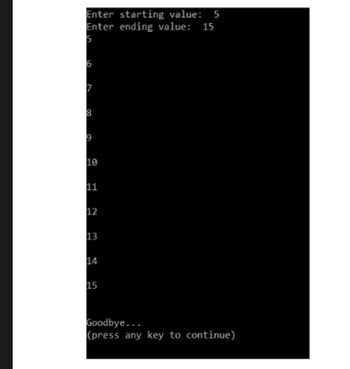
Database System Concepts
7th Edition
ISBN: 9780078022159
Author: Abraham Silberschatz Professor, Henry F. Korth, S. Sudarshan
Publisher: McGraw-Hill Education
expand_more
expand_more
format_list_bulleted
Question
I need help with a

Transcribed Image Text:The image displays the output of a simple console-based program which asks the user to input a starting and an ending value.
Here is a transcription of the text:
```
Enter starting value: 5
Enter ending value: 15
5
6
7
8
9
10
11
12
13
14
15
Goodbye...
(press any key to continue)
```
### Explanation:
1. **User Input:**
- The program prompts the user to enter a "starting value." In this instance, "5" is entered.
- Next, the user is asked for an "ending value," to which "15" is input.
2. **Output Display:**
- The program outputs a sequential list of numbers ranging from the starting value (5) to the ending value (15).
3. **Program Conclusion:**
- The message "Goodbye..." signals the end of the program.
- The prompt "(press any key to continue)" indicates that the user can press any key to terminate or exit the program.
### Educational Context:
This program is a basic example often used to teach beginners about loops, user input, and output in programming. It helps learners understand how to iteratively generate sequences based on user-defined conditions.
SAVE
AI-Generated Solution
info
AI-generated content may present inaccurate or offensive content that does not represent bartleby’s views.
Unlock instant AI solutions
Tap the button
to generate a solution
to generate a solution
Click the button to generate
a solution
a solution
Knowledge Booster
Similar questions
- Q3: - Write a visual hasic program that reads two integers (feet and inches) representing distance, then converts this distance to meter. Use two text boxes for reading the two integer numbers and print the result in picture box. Note: 1 foot = 12 inch 1 inch = 2.5 Cmarrow_forwardI want to thank you experts for the program below. The output image is great but I'm having a problem with line 63, so I can't run the program. I am using Visual Studio 2019, C++ console for Windows 10. Could you please use the Visual Studio 2019 and help with this error. I have attached an screenshot image. Thank you very much. Modified code: #include <iostream> using namespace std;//#define NCOLS 3 //constant declarationconst int NCOLS=3; //function to convert 1D array to 2D arraybool copy1DTo2D(int d1[], int size, int d2[][NCOLS], int nrows){ //checking the given condition if(size == NCOLS*nrows){ //copying the elements of 1D array to 2D array one by one for(int i=0; i<size; i++){ d2[i/NCOLS][i%NCOLS] = d1[i]; } return true; } else{ return false; }} //function to convert 2D array to 1D arraybool copy2DTo1D(int d2[][NCOLS], int nrows, int d1[], int size){ //checking the given condition if(size ==…arrow_forwardNo plagarism please! Code with comments and output screenshot is mustarrow_forward
arrow_back_ios
arrow_forward_ios
Recommended textbooks for you
 Database System ConceptsComputer ScienceISBN:9780078022159Author:Abraham Silberschatz Professor, Henry F. Korth, S. SudarshanPublisher:McGraw-Hill Education
Database System ConceptsComputer ScienceISBN:9780078022159Author:Abraham Silberschatz Professor, Henry F. Korth, S. SudarshanPublisher:McGraw-Hill Education Starting Out with Python (4th Edition)Computer ScienceISBN:9780134444321Author:Tony GaddisPublisher:PEARSON
Starting Out with Python (4th Edition)Computer ScienceISBN:9780134444321Author:Tony GaddisPublisher:PEARSON Digital Fundamentals (11th Edition)Computer ScienceISBN:9780132737968Author:Thomas L. FloydPublisher:PEARSON
Digital Fundamentals (11th Edition)Computer ScienceISBN:9780132737968Author:Thomas L. FloydPublisher:PEARSON C How to Program (8th Edition)Computer ScienceISBN:9780133976892Author:Paul J. Deitel, Harvey DeitelPublisher:PEARSON
C How to Program (8th Edition)Computer ScienceISBN:9780133976892Author:Paul J. Deitel, Harvey DeitelPublisher:PEARSON Database Systems: Design, Implementation, & Manag...Computer ScienceISBN:9781337627900Author:Carlos Coronel, Steven MorrisPublisher:Cengage Learning
Database Systems: Design, Implementation, & Manag...Computer ScienceISBN:9781337627900Author:Carlos Coronel, Steven MorrisPublisher:Cengage Learning Programmable Logic ControllersComputer ScienceISBN:9780073373843Author:Frank D. PetruzellaPublisher:McGraw-Hill Education
Programmable Logic ControllersComputer ScienceISBN:9780073373843Author:Frank D. PetruzellaPublisher:McGraw-Hill Education

Database System Concepts
Computer Science
ISBN:9780078022159
Author:Abraham Silberschatz Professor, Henry F. Korth, S. Sudarshan
Publisher:McGraw-Hill Education

Starting Out with Python (4th Edition)
Computer Science
ISBN:9780134444321
Author:Tony Gaddis
Publisher:PEARSON

Digital Fundamentals (11th Edition)
Computer Science
ISBN:9780132737968
Author:Thomas L. Floyd
Publisher:PEARSON

C How to Program (8th Edition)
Computer Science
ISBN:9780133976892
Author:Paul J. Deitel, Harvey Deitel
Publisher:PEARSON

Database Systems: Design, Implementation, & Manag...
Computer Science
ISBN:9781337627900
Author:Carlos Coronel, Steven Morris
Publisher:Cengage Learning

Programmable Logic Controllers
Computer Science
ISBN:9780073373843
Author:Frank D. Petruzella
Publisher:McGraw-Hill Education